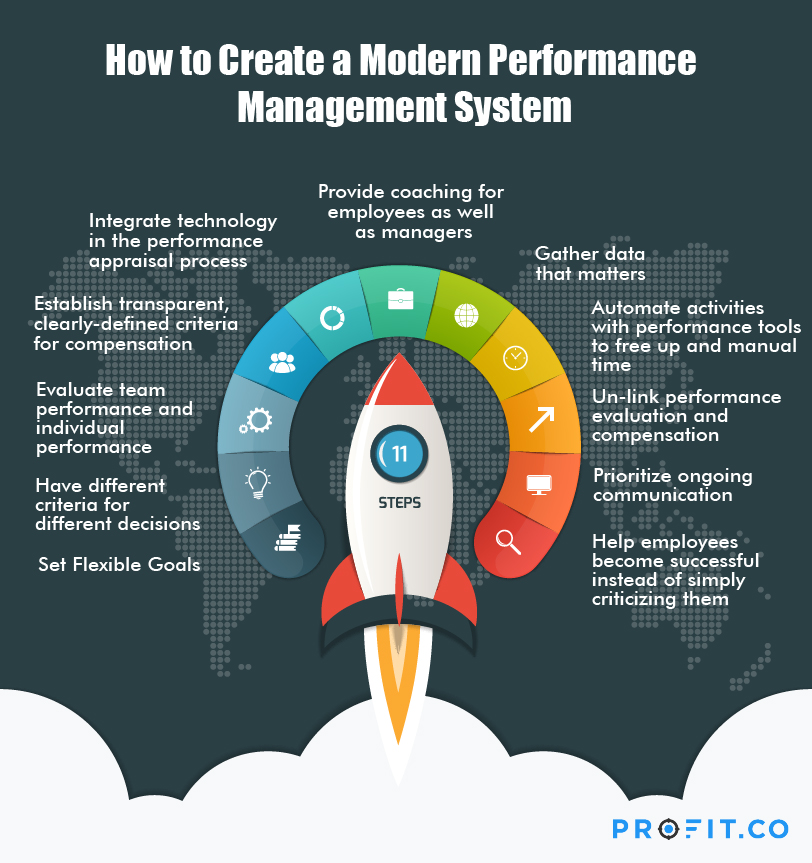Performance Management systems are adapting quickly to the changing business models and the requirements of evolving employee expectations.
Every organization has a performance management system in place. However, managers and staff don’t always find it very helpful. It evokes mixed feelings amongst employees. Many times the results are called into question due to insufficient time, effort, and investment spent on reaching the evaluation outcome.
As a result, managers and employees alike think that performance management systems are both stressful and subjective. The lack of motivation and belief surrounding this process might impact a review’s ability to improve employee performance. In fact, existing performance management systems might end up having a negative impact on employees, as they can get caught up worrying about compensation and the details of the rating system and feedback.
To win in the marketplace you must first win in the workplace.
Changing paradigms of performance
There have always been issues with performance management systems– lately, they’ve become more obvious as job responsibilities have evolved. More and more positions need employees to have rich expertise, the ability to make judgement calls without guidance, and have stellar problem-solving skills. Employees are expected to live up to higher expectations each and every year– therefore, traditional performance appraisal processes simply don’t make sense for the modern employee.
And yet, so many companies still use outdated systems and processes. So many organizations are hesitant to make a change because they don’t know what a new performance management system would look like. What will happen if year-end performance reviews are gone? How will the new one work? Will it work well? Will performance become better or or will it become worse?
Performance Management Trends
Big companies are making changes. Soon, smaller companies will follow suit. Patterns are beginning to emerge:
Key trends in performance management systems:
- Big companies are testing new ideas that give employees constant feedback and coaching.
- The nature of some companies are such that their objectives can change quite rapidly. Such companies cannot measure their employees’ performance against annual objectives.
- Companies are collecting more objective performance data through systems that automate real-time analyses.
- Better data is bringing about a shift in emphasis from reflective evaluations to fact-based performance and development discussions, which are becoming frequent and as-needed rather than annual events.
Research and surveys show that there’s no need to reinvent the wheel when it comes to new performance management systems. The key is to conduct performance reviews in such a way that they improve individual and team performance in alignment with organizational objectives and priorities, and the employee experience and business outcomes.
What is a modern performance management system?
Modern management processes are moving towards customization, flexibility, and agility. Following are some of the key changes that will be considered essential for any progressive performance management system:

- Set flexible goals
- Different criteria for different decisions
- Team performance vs. Individual performance
- Clearly defined criteria for compensation
- Integrate technology in the performance appraisal process
- Giving feedback
- Get data that matters
- Performance tools can automate activities, freeing up manual time
- Un-link performance evaluation and compensation
- Prioritize ongoing communication
- Help employees become successful instead of pulling them down
1. Set flexible goals
Instead of having a top-down approach when setting annual SMART goals, set flexible goals that allow goal owners to tailor the format and timeline to the changing needs of the company.
2. Different criteria for different decisions
Use different criteria for different decisions to ensure ratings are fair instead of using performance ratings as the basis of all talent decisions, compensation and promotion. Calibration sessions should be conducted to ensure ratings are fair.
3. Team performance vs. Individual performance
Organizations are not about individual performance anymore. As human beings, it’s hard for us to function alone. How an employee performs within a team and within an organization is what defines success. Organizations that focus on team or project objectives perform far better than those that focus on individuals.
4. Clearly defined criteria for compensation
It can be very discouraging when an employee feels that their compensation is unfair and does not match their contributions to the company. Therefore, it’s very important to have a compensation plan in place that is transparent, clearly defined, and easy to understand. This plan must be clearly established with everyone in the organization so that there is no ambiguity in what to expect.
5. Integrate technology in the performance appraisal process
Organizations that integrate performance tools into their team’s workflow are much more likely to see positive results from the process. Making performance feedback a natural part of day-to-day work makes it easier to coach employees and managers alike.
6. Giving feedback
Giving feedback is a crucial part of the performance appraisal process. However, this feedback is of no use if employees don’t know what to do with the feedback. Managers need development to show their team how to get work done well. While this is beneficial to the employees, it’s also beneficial for managers who are evaluated on their ability to engage their teams.
7. Get data that matters
Organizations and people go through so many changes during the course of a year. Therefore, annual evaluations will not give the most accurate depiction of employee performance and experience. Good data is very important for a fair evaluation. Organizations can get high quality data by using systems that collect information on employee performance on a regular basis. Gathering performance data year-round means that the company is getting better insights on employee performance and employees are receiving more accurate evaluations.
8. Performance tools can automate activities, freeing up manual time
When performance tools are integrated into the workflow, it not only automates activities, freeing up time that managers and employees would have otherwise spent to gather data, but it also gathers more meaningful and insightful feedback. The quality of information gathered is of better quality because data is more recent and relevant to the review at hand, and therefore more credible. Companies are now using artificial intelligence and machine learning to gather continuous, real time information, improving the quality of data exponentially.
9. Un-link performance evaluation and compensation
Traditional reviews link performance evaluations, ratings, and compensation. This might seem very logical: better performance means more pay, weak performance means less pay. This logic is in line with the Bell Curve method. However, recent findings in cognitive sciences and behavioral economics prove that linking performance ratings and compensation in this way is not the right way to go when it comes to employee motivation. Linking performance with pay can demotivate employees and cause them to take less risks and be unwilling to grow outside of their comfort zone. This stunts the employee’s professional development as well as the company’s overall growth.
10. Prioritize ongoing communication
An informal communication between the manager and employee gives the manager a chance to check-in on the employee’s performance. It gives an opportunity for them to discuss priorities one-on-one so that their goals stay aligned.
Employees appreciate frequent and consistent feedback. When managers check in with their team members on a regular basis, it has a significant impact on the employee’s performance and on employee-manager bonding. It leads to more trust and respect for their managers, and they believe that there is potential for them to grow in the organization.
This clearly indicates that feedback is more relevant and effective when it’s given in the moment rather than when it’s delivered after the fact. This is not effective at all because when feedback finally gets delivered to the employee all at once at the end-of-the-year review, it has lost all steam. Important achievements may have been overlooked and more recent events may have been given too much importance. Feedback offered at the end of the year is not relevant or reliable and it’s usually too focused on the past instead of looking at the opportunities that lie ahead. This, in turn, makes employees feel unappreciated and unacknowledged, gradually leading to disengagement.
11. Help employees become successful instead of pulling them down
One-on-one check-ins help catch performance issues early on rather than waiting weeks or months to discuss them. Honesty goes a long way in gaining the employee’s trust and in helping them understand where they truly stand in the whole scheme of things. It’s about giving them feedback and working with them to put a plan together on how they can improve instead of pulling them down. If the employee is successful, the team and the organization are, too.
It’s important to have all of this information stored in one place that employees and managers have access to. The system allows managers across different levels of management to help plan what they need to achieve over the course of the next few months. When everybody can see everybody’s goals, employees can see what their goals are and how they can help their manager, which, in turn, helps them contribute to the bigger picture.
In Conclusion
The future belongs to those who adapt. Performance management is continually evolving and responding to the fundamental changes in organization structures, business models, the nature of work and the needs of the employees.
The nature of every organization is different and has its own performance objectives. It’s important that all employees know what the organization stands for, and what its purpose is. Only then can employees align their efforts with the purpose of the organization. And for that to happen, organizations must do away with old models of performance management systems and make way for updated, more effective methods.
To learn about Profit.co’s flexible performance management module, book a free demo with our experts, or try Profit.co completely free for thirty days!

